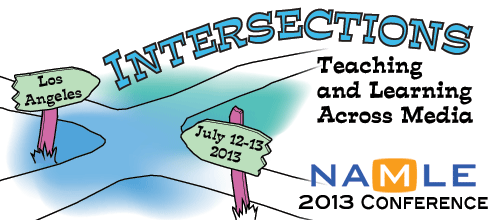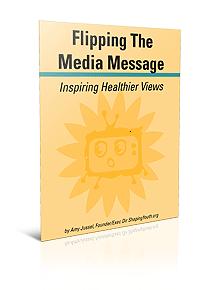 July 8, 2013 Gearing up for speaking at my first ever National Association for Media Literacy Education (NAMLE) conference this coming weekend, I’m taming butterflies as I’m honored to be on a powerhouse panel with academic rockstars like Lisa Guernsey, author of Screen Time: How Electronic Media – From Baby Videos to Educational Software – Affects Your Young Child.
July 8, 2013 Gearing up for speaking at my first ever National Association for Media Literacy Education (NAMLE) conference this coming weekend, I’m taming butterflies as I’m honored to be on a powerhouse panel with academic rockstars like Lisa Guernsey, author of Screen Time: How Electronic Media – From Baby Videos to Educational Software – Affects Your Young Child.
I’m eager to hear best practices in pop culture and learning from all the panelists, and thought I’d preview my chat on the “power of play” which will be more of a conversational “show and tell” of some favorite tactics, as well as fun teaching tools and health literacy links which I’ve dropped into the media mix below.
This particular “Dare To Compare: Gross Out Game for Good Nutrition” uses pop culture product placement, current ads and promos to dissect popular snacks and upend inconsistent pitches for sports and energy drinks, by celebrities and athletes. Using the same persuasive tools and techniques of advertising insiders, we flip the message in a healthier direction, teaching kids how to be critical consumers in mind/media, and in this case, munchies and meals.
I’ll demo ways we’ve incorporated media literacy and health sciences into tactile, sensory-based ‘gross-out’ games, blending in label literacy for good nutrition and kids’ creations as ‘junior advertisers” creating their own pitch and product.
It’s a hoot to watch children “get it” using the power of play in education, as they begin to connect the dots of what happens with the creation of a “manufactured need. Each of their branded creations and interpretations of ‘what would sell’ are voted upon in peer to peer ‘American Idol’ style, then uploaded and showcased via Animoto as a music video.
Granted, in the activity to ‘brand bottled water’ some of the name generation coming out of 4th and 5th graders worldviews has been an eye-brow raising double-take, but it clearly reveals the pop culture influence and dynamics of age compression and ‘growing up too soon,’ so often turns out to be a worthwhile sociological snapshot to boot.
Animoto used as a digital teaching tool is an easy, turnkey way to engage kids in media as “makers” so they can see their own work in a fun, digital storytelling format. It’s also been perfect for uploading body image and Photoshop falsehoods while enabling kids to find and cite examples of the growing pressure to be ‘hot.’ (damaging appearance-based cues that impact their physical AND socio-emotional wellness)
 By using media literacy to ‘lift and reveal’ the dollar driven agenda, and health literacy to ‘counter-market’ some of the confusing cues (e.g. irksome fast food Olympics’ sponsors, soda/sports ‘pouring rights’ in schools, junk food chomping fashion models, with ‘eat this, but look like THIS’ demands, which ultimately “sell” insecurity for profit) kids become aware of how they’re being used.
By using media literacy to ‘lift and reveal’ the dollar driven agenda, and health literacy to ‘counter-market’ some of the confusing cues (e.g. irksome fast food Olympics’ sponsors, soda/sports ‘pouring rights’ in schools, junk food chomping fashion models, with ‘eat this, but look like THIS’ demands, which ultimately “sell” insecurity for profit) kids become aware of how they’re being used.
It can upend and flip the script with ‘aha’ moments about the influence of name brands, peer pressure, and junk food that leads beyond ‘awareness’ to self-empowerment, free agency, and critical thinking. This intersection of old and new media depicts how we can take hands-on activities in the classroom and engage kids through inquiry-based learning and media, to uplift and inspire w/indie thought.
For more, just click on our “nutrition/wellness” category for articles/links/updates on media and food marketing in pop culture. Meanwhile, here are a few of my favorite digital tools and wellness resources to ‘reach and teach’ leveraging the power of play…
Shaping Youth’s Online Resource Roundup
Food for Thought: Some Favorite Teaching Tools, Health Literacy
Brian Wansink Ph.D. Food & Brand Lab:
Teaching Toolbox on his site MindlessEating.org
Fun “One Page Wonders” in-class activities
Full Class Session Modules free health literacy games
Food Facts.com: “Find out what’s really in your food” (ingredients/allergens/claims)
Digital Ads.org: Interactive food & beverage marketing case studies (industry tactics)
Food Marketing.org: 125+orgs/academics working to eliminate harmful food marketing
Healthy School Foods Now: Interactive look at new school meal/snack standards
CSPI Center for Science in the Public Interest food analysis, policy/advocacy
Nutrition Action Newsletter CSPI’s subscriber-based health literacy
Prevention Institute: Claiming Health: Front of package labeling of children’s foods
Infographics, Visual Insights, Interactives, Digital Tools For Health Literacy
RWJF/Pew School Snacks handy infographic Healthy School Foods Now.org
School lunch interactive: Calculating the cost/choices w/set amount of lunch money
CSPI: Is Menu Labeling Working?
Media Smarts, Canada: Interactive unit: food marketing on the web (bkgd for educators)
PBS Kids: Don’t Buy It Get Media Smart (food advertising tricks, design a cereal box)
Nourish Interactive health games, teaching aids, nutrition tools
Playnormous.com health games, edu/research/role play, creators of Escape from Diab
How Obesity Harms a Child’s Body and fast food A-Z nutrient charts
Children’s Nutrition Research Ctr/Baylor: healthy eating calculator/energy
Nutrition Data: (Self) Conversions, calories, nutrients
Local Harvest.org Find a farmer’s market near you
Eat This, Not That Kids food menu grades
Cybraryman: Calculators and nutrition in schools/link list
2013: Latest Policy/Research, Fact Sheets/Articles: Food Marketing to Kids
USDA New policy: Smart Snacks in School (synopsis)
USDA Food & Nutrition School Snacks Full Document: June 28, 2013 (54pp pdf)
World Health Org June ‘13: Marketing Junk Food to Kids: “Disastrously Effective”
World Health Organization: Sodium intake for adults/children: (53pp pdf)
FTC Updated Report (M.Nestle/summary) Food Marketing to Kids (356pp pdf)
ThinkProgress: American Heart Assn Study: 80% of US teens on way to heart disease
Healthland Time: What the New USDA Healthier Snack Rules Mean for Schools
NYTimes, Feb ‘13: The Extraordinary Science of Addictive Junk Food v Michael Moss’ new book “Salt, Sugar, Fat: How the Food Giants Hooked Us”
Prevention Institute: The Facts on Junk Food Marketing and Kids
JAMA, June ’13: Study Examines Hispanic Youth Exposure to Food/Beverage/TV Ads
New Stanford study published in Psychological Science: Nutritional awareness through food-themed stories helps preschoolers eat healthier voluntarily
CCFC Food Marketing Resources (+food marketing fact sheets & stats)
10 Gross Food Finds Ingredients In Your Food (useful in counter-marketing games)
Best Practices & Handful of Wellness Resources for Child Nutrition:
No Kid Hungry.org best practices in nutrition education
Choose My Plate.gov (replaces My Pyramid)
NIH kids: Portion distortion, serving size quizzes
CDC Health Literacy Goals, standards, activities by region/state
FDA Updated Food Labeling Guide details on nutrition labels & health claims
The Food Studies Institute K-4 “Food is Elementary” health literacy
Healthy Child.org safer foods, environmental info on chem cuisine/kids
Food and Health.com culinary resources for health educators
Help Guide.org: Nutrition/healthy eating guide for children/teens (overview)
Nutrition Vision consumer/pro resources for digital health
Zamzee.com Activity meter (fee-based accelerometer/health gamification) Hope Labs
A Few Best Practices in Nutrition Education
- Introduce new foods early, often: 10-15 times in social context (family/peers)
- Engage kids with active participation (garden, shop, cook, create: hands-on)
- Familiarize, use taste tests, get acceptance early (trial size bites, healthy habits)
- Focus on healthy eating behaviors/outcomes vs food specific vitamins-nutrients
- Use self-assessment/feedback (evaluate family access/environment/culture: relate)
- Teach parents “why to buy” tips/health habits (empower child/change agent, +peer to peer social norming)
Shaping Youth’s “Dare to Compare” Gross Out Game for Good Nutrition: Blends Pop Culture & Persuasion
Power of Play: Wellness Sessions from ShapingYouth.org
- Mystery munch: Introducing a new food, positive reinforcement
- Diet dissection: “Ewww! What are you REALLY eating?” negative reinforcement
- Label lingo: “Watch out” words/ingredients, health literacy & food ads/packaging
- Sim City: Hands-on, tactile simulations/role play (jumping jacks with 5pound cans in aprons, feel the fatigue; playdough extruder/clogged arteries, etc)
- Switch Pitch: Suggestions for healthier replacements, baby steps in intervention
Counter-Marketing/Behavioral Intervention: Methods Using Pop Culture Cues, Part of M-power Media Lit/Entertainment Series
- Change the channels of influence
- Tap into emotional triggers (acceptance, belonging, popularity, etc)
- Find behavioral motives
- Flip the allure, disrupt the cycle, put kids ‘in the know’
- Balance the message, shift the rationale (‘follow the money trail’)
- Precedent, Persuasion, Peer Perpetuation:
- Shaping Youth Classroom Sessions (examples)
- ShapingYouth: Snack Attack/Sports Teams (counter-marketing junk)
- Using Shrek Against His Drek: Getting Kids to Eat Green
- Using Marketing Methods to “Sell” Kids Healthier Food
- Selling Kids Healthy Cuisine Through Product Presentation
- Eat Like An Ape: The Media Circus At Work
- Shaping Youth’s Gross Out Game for Good Nutrition
Helpful teaching model: BJ Fogg, Stanford Persuasive Technology Lab: Behavior Model.org
Food for Thought: Media to Digest for Healthier Kids
- Yuck! Movie: 4th grader Zachary Maxwell’s docu short on school lunch (19m)
- A Wake Up Story: short video clip on child dev/health (under 4m)
- Kids documentary: Food politics: What’s On Your Plate?
- Cartoon Media: Backwards Hamburger (Fast Food Nation/activism)
- Cartoon Media: The Meatrix (Free Range Studios/activism)
- DOOF: Food Backwards (Videos: tracing where food comes from, new game)
- 10 Top Food Films/Educators: A Place at the Table, Food Inc, SuperSize Me, Food Fight, King Corn, Films for Action: Food videos (free to watch online)
- Story of Stuff series, including: Bottled Water
Packaging Lingo: Weasel/Watch Words for Teaching Health Literacy to Kids (see CSPI)
“Part of…” (a balanced diet)
(a healthy breakfast)
“The taste of real…”(butter, cheese, fruit…)
“Supports, enhances, maintains, suppresses (hedging on product claims, NO FDA guidelines…Also note “Structure/function claims”…examples:
“Optimizes” (bone health…)
“Helps promote” (urinary health)
“Maintains” (healthy lung function)
“This evidence is not conclusive” (beware of disclaimers, especially after wordy FDA ‘preliminary evidence’ scientific sounding product claims)
– Dietary supplements (lots of fuzz, unregulated)
– Portion distortion (One bag of “Flamin’ Hot Cheetos”= 3 servings, 760mg of sodium!)









Hi! We found your website through the #FoodDayChat on Twitter. You’ve found a lot of great resources for children’s food education! You may be interested in No A? Walk Away!, a free educational program designed to teach children and families about restaurant food safety. It includes funny videos, hands-on activities, teaching resources, and an advocacy program.
I’ll check it out, thanks! What does the name refer to? (“No A? Walk Away”) I’ll go surf the site and find out, meanwhile, thanks for the outreach, yes, that was an AMAZING #FoodDayChat…I could barely keep up with all the resources flinging about! Thank goodness for recaps and Twitter streams 😉 I’ll be back again on 2-24 to see what they’re up to…Best, Amy